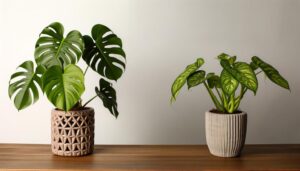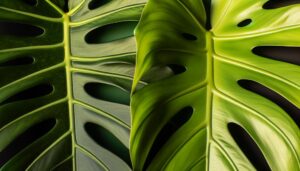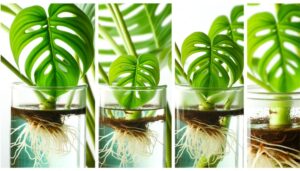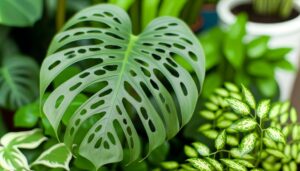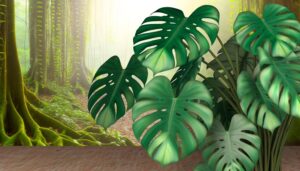Difference Between Monstera Deliciousa and Monstera Borsigiana
Monstera deliciosa and Monstera borsigiana differ significantly. Monstera deliciosa has larger, thicker leaves up to 3 feet wide with deep, irregular fenestrations, while Monstera borsigiana's leaves are thinner, around 1.5 feet, with smaller, symmetrical holes.
Deliciosa spreads out horizontally, needing ample space, whereas Borsigiana climbs vertically with closely spaced nodes, appearing denser. Deliciosa has thicker stems and spaced-out nodes; Borsigiana's are slender.
Both thrive in high humidity and bright, indirect light, although Borsigiana tolerates lower light better. Explore the specifics for a deeper understanding.
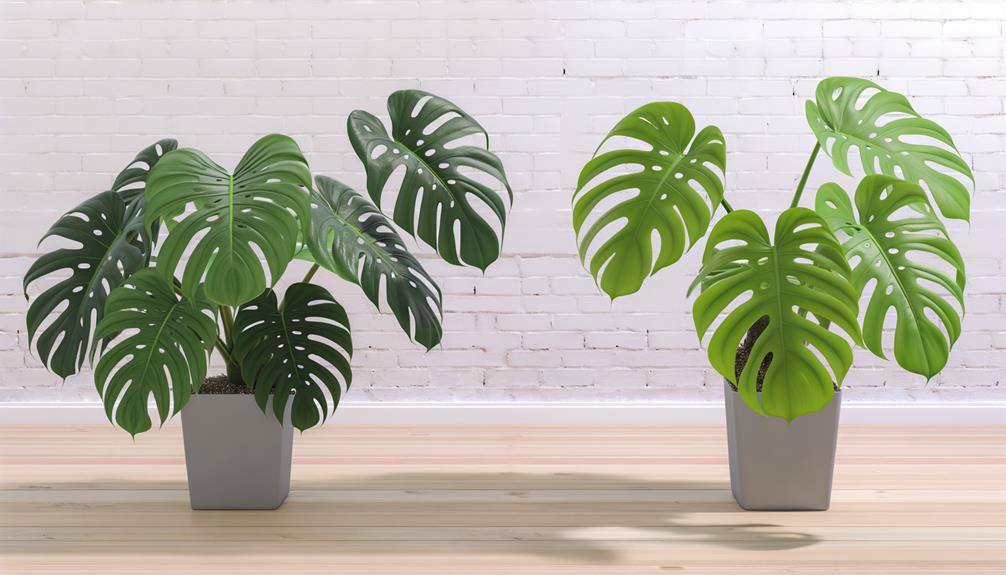
Key Takeaways
- Monstera deliciosa has larger, thicker leaves up to 3 feet in diameter, while Monstera borsigiana's leaves are thinner and max out at 1.5 feet.
- Monstera deliciosa exhibits a sprawling, horizontal growth habit, whereas Monstera borsigiana climbs vertically using aerial roots.
- Monstera deliciosa's stems are thicker with more spaced-out nodes, leading to further leaf attachment.
- Monstera deliciosa has larger, irregularly shaped leaf holes; Monstera borsigiana's perforations are smaller, symmetrical, and orderly.
- Monstera deliciosa prefers bright, indirect light, while Monstera borsigiana tolerates lower light levels.
Leaf Shape and Size
When distinguishing Monstera deliciosa from Monstera borsigiana, you'll notice that the former typically has larger, more deeply fenestrated leaves. Monstera deliciosa, also known as the Swiss Cheese Plant, features leaves that can reach up to 3 feet in diameter, with pronounced splits and holes.
In contrast, Monstera borsigiana has smaller leaves, usually topping out at around 1.5 feet, with less extensive fenestration. Additionally, the leaf texture differs; Monstera deliciosa leaves are thicker and more leathery, whereas Monstera borsigiana's leaves are thinner.
These differences in leaf morphology not only affect the plant's aesthetic appeal but also its adaptability to various indoor environments. Understanding these distinctions will help you appreciate the unique characteristics of each species.
Growth Habit
Monstera deliciosa exhibits a more vigorous, sprawling growth habit compared to the more compact and climbing nature of Monstera borsigiana. You'll notice that Monstera deliciosa tends to spread out, with its large leaves unfurling on a more horizontal plane, creating an expansive display. This species often requires more space due to its robust and widespread growth pattern.
On the other hand, Monstera borsigiana has a more vertical inclination. It climbs efficiently using aerial roots to latch onto supports, making it ideal for tighter spaces or vertical gardening. Its growth is more streamlined, conserving space while still achieving impressive height.
Understanding these distinctions can help you choose the right Monstera for your specific indoor or outdoor gardening needs.
Stem and Node Differences
You'll often notice that Monstera deliciosa has thicker, more robust stems compared to the more slender and flexible stems of Monstera borsigiana. This difference is essential for identifying these two species. The nodes on Monstera deliciosa are more spaced out, leading to larger gaps between leaves, while Monstera borsigiana features closely spaced nodes, resulting in a denser foliage pattern.
| Feature | Monstera deliciosa | Monstera borsigiana |
|---|---|---|
| Stem Thickness | Heftier and more robust | Slender and flexible |
| Node Spacing | More spread out | Closely spaced |
| Leaf Attachment | Further apart due to node spacing | Closer together due to dense nodes |
| Structural Support | Provides stronger support | More reliant on support structures |
Understanding these differences helps you care for and distinguish between these Monstera varieties effectively.
Fenestration Patterns
Fenestration patterns serve as a key distinguishing feature between Monstera deliciosa and Monstera borsigiana, with the former showcasing larger, more irregularly shaped leaf holes compared to the latter's smaller, more uniform perforations.
When you examine Monstera deliciosa (Monstera deliciosa Liebm.), you'll notice its leaves develop extensive, asymmetrical fenestrations that can span half the leaf's width. These holes are usually uneven, contributing to the plant's distinctive appearance.
In contrast, Monstera borsigiana (Monstera deliciosa var. borsigiana) presents with more orderly, symmetrical perforations that are typically smaller and consistent in shape. This regularity in fenestration can help you quickly identify it.
Understanding these differences allows you to distinguish between the two species accurately, enhancing your botanical knowledge and appreciation.
Care Requirements
Caring for Monstera deliciosa and Monstera borsigiana involves providing ideal light, humidity, and soil conditions tailored to each plant's specific needs. Monstera deliciosa thrives in bright, indirect light, while Monstera borsigiana can tolerate lower light levels. Both species prefer high humidity, around 60-70%, and well-draining, peat-based soil to prevent root rot. Regular watering is essential, but make certain the top inch of soil dries out between waterings.
| Care Aspect | Monstera deliciosa | Monstera borsigiana |
|---|---|---|
| Light | Bright, indirect light | Tolerates lower light |
| Humidity | 60-70% | 60-70% |
| Soil | Well-draining, peat-based | Well-draining, peat-based |
| Watering | Regular, let top inch dry out | Regular, let top inch dry out |
Proper care guarantees lush growth and vibrant foliage for both species.
Conclusion
After exploring leaf shape and size, growth habits, stem and node differences, and fenestration patterns, you might think you've got it all figured out. But here's the twist—care requirements can still throw a curveball.
Monstera deliciosa and Monstera borsigiana may look similar, but their distinct needs could make or break your plant-parenting experience.
So, are you ready to dive deeper and truly master these alluring species? The journey has only just begun.

